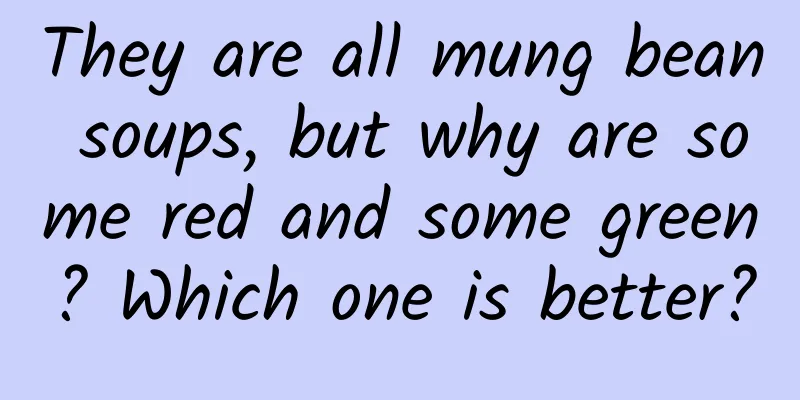They are all mung bean soups, but why are some red and some green? Which one is better?

|
It is the dog days of summer, and mung bean soup is considered a great way to relieve summer heat. Whether it is the mung bean soup with distinct grains or the mung bean paste with the mung bean flowers blending into the soup, they all delight our taste buds. Observant friends must have noticed that sometimes mung bean soup is green, and sometimes it turns into an attractive red. Why is there such a difference in color? Which one is healthier? Copyright images in the gallery. Reprinting and using them may lead to copyright disputes. Why is mung bean soup red and green? The color of mung bean soup can be green or red, which is related to whether the polyphenols in the mung beans are oxidized . When the polyphenols come into contact with oxygen during the heating process, they are oxidized and become quinones, and the color changes from green to red. Whether polyphenols are easily oxidized depends mainly on the following factors: 1 Water Quality The harder the water, the more minerals it contains. Mineral ions can chelate with polyphenols, reducing their antioxidant capacity, and the color will turn red. For example, in some areas in northern China, tap water contains more mineral components, so the mung bean soup cooked in it tends to be reddish. If you use purified water or soft tap water to cook mung bean soup, the color will usually be green. In addition, the pH value of water will also affect the color. In an acidic environment, mung bean soup will remain green, while in an alkaline environment, mung bean soup will turn red. For example, if alkali is added when cooking mung bean soup, the color will turn red. 2 Cooking time and method If the cooking time is short , the mung bean soup is usually green . If it is cooked for a long time or boiled repeatedly , the polyphenols in the mung beans will be fully exposed to oxygen and oxidized, and it will easily turn red . For example, if you cook the mung bean soup over low heat for a long time, the possibility of it changing color increases. Copyright images in the gallery. Reprinting and using them may lead to copyright disputes. 3 Exposure to air Mung bean soup will also easily turn red if exposed to the air for a long time after cooking. For example, if the cooked mung bean soup is not covered with a lid in time, a large amount of air will enter, which may accelerate its oxidation and discoloration. 4 Container material When using metal containers such as iron pots to cook mung bean soup, the metal ions may react with the ingredients in the mung beans, causing the color to turn red . Cooking in a casserole or stainless steel pot is relatively less likely to change color. What color is the mung bean soup? Better and healthier? To understand which color of mung bean soup is more nutritious and healthier, we need to first understand the ingredients of mung bean soup. Mung bean soup has always been considered a good product for relieving summer heat. In fact, the benefits of mung bean soup are more than that. 1 Low GI Mung beans belong to the category of beans, similar to rice, millet, and oats, and are mainly used as staple foods in the diet. However, compared with other staple foods, mung beans have low carbohydrates and a slower rate of raising blood sugar , with a glycemic index of only 27 (lower than 55, a low GI food). Compared with other cereal soups, mung beans are very suitable for diabetics. The GI is related to the dietary fiber content, starch type, etc. Data source: Chinese Food Composition Table (Standard Edition/Volume 1) and Verywell Health Of course, the GI is also closely related to the degree of cooking. If it is cooked into mung bean paste, the blood sugar level will definitely rise faster than that of mung bean soup, but it has no direct relationship with the color of the soup. 2 high protein As a miscellaneous legume, mung bean has a high content of protein, with a protein content of up to 21%~28% , which is twice that of eggs and comparable to meat. In addition, unlike other coarse grains, its protein is complete protein, and its digestion, absorption and utilization rate are relatively high. Data source: "Chinese Food Composition Table (Standard Edition)" However, the protein content is not affected by the color of mung bean soup. 3 Rich in dietary fiber The dietary fiber content of mung beans is as high as 16.3%. They are rich in soluble dietary fiber such as oligosaccharides, which can promote the proliferation of intestinal probiotics and play an important role in maintaining the balance of intestinal microecology. In addition, insoluble dietary fiber can help stimulate intestinal motility, prevent and relieve constipation. Image source: "Chinese Nutrition Science Encyclopedia (Second Edition/Volume 1)" Like protein, dietary fiber is a "stubborn component" among nutrients. It is not easily affected by factors such as temperature and oxygen and is relatively stable. 4 Rich in B vitamins, potassium and other ingredients In summer, people sweat a lot, and some water-soluble vitamins, potassium and other minerals are easily lost with sweat. Mung beans are rich in vitamin B1, B2 and potassium, which are beneficial ingredients for relieving heat (electrolyte metabolism disorders can cause heat stroke). Data source: "Chinese Food Composition Table (Standard Edition/Volume 1)" Vitamin B1 and B2 are stable in acidic environments and easily destroyed in alkaline environments. For example, when the pH is less than 5, vitamin B1 can still maintain physiological activity when heated to 120°C; boiling at pH>7 can destroy most or all of it. In most cases, the difference in color has little to do with these vitamins and minerals. However, if the green bean soup turns red because alkali is added when cooking, then the green one has more B vitamins than the red one. 5 Rich in polyphenol antioxidants Mung beans contain a wide variety of phytochemicals, such as plant sterols, polyphenols and other antioxidants. Among them, polyphenol antioxidants play an important role in removing free radicals and delaying aging. Once mung beans are boiled into mung bean soup, the amount of polyphenols is affected by the degree of oxidation. The higher the degree of oxidation, the redder the color of the mung bean soup and the less polyphenol content. Copyright images in the gallery. Reprinting and using them may lead to copyright disputes. Overall, in most cases, there is no significant difference in nutritional value between red and green mung bean soup (when adding alkali to the porridge causes discoloration, the green one is more nutritious than the red one), but the green one is better in terms of health benefits. Mung bean soup tastes better when cooked this way These points are very important to cook a bowl of delicious and heat-relief mung bean soup. 1 Material selection Choose fresh, insect-free, and mold-free high-quality mung beans, wash them and soak them for 2 to 3 hours to shorten the cooking time. If you want to make soup in the morning, you can also soak them a day in advance, seal them, and refrigerate them. 2 Water Quality Try to use soft water or purified water to reduce the impact of minerals on the soup color. In this way, you can harvest green mung bean soup! If the water at home is hard, you can also squeeze a small amount of lemon juice or white vinegar into the soup, which is also conducive to the protection of polyphenols. 3 Cookware If you want to get mung bean soup richer in polyphenols, you can use stainless steel pots, casseroles or glass pots instead of iron pots and other pots to prevent metal ions from chelating with polyphenols and reducing the antioxidant effect. 4 Heat After boiling over high heat, turn to low heat and simmer, keeping it at a slight boil to avoid long-term high-temperature boiling that may cause nutrient loss and color change. The overall duration should be controlled within 1.2 hours. In addition, cover the lid during boiling to avoid prolonged contact with air. Copyright images in the gallery. Reprinting and using them may lead to copyright disputes. 5 Seasoning You can add red dates, white fungus and other ingredients according to your personal taste to improve the taste and nutritional value, but you need to pay attention to controlling sugar intake. In addition, if you add white sugar, you can add it before drinking to prevent sugar from affecting the dissolution of polyphenols and reducing the polyphenol content of mung bean soup. 6 save The cooked mung bean soup should be consumed as soon as possible to avoid long-term storage which may cause bacterial growth. If it needs to be stored, it should be refrigerated and consumed within 24 hours. It should be noted that do not add alkali when cooking mung bean soup. Although it will make it easier to cook, the B vitamins and phenolic substances will be greatly destroyed. Drink mung bean soup, these friends should pay attention 1 Abnormal blood sugar Mung beans themselves raise blood sugar slowly. However, when cooking them, do not add noodles or rice to the soup, and do not cook it too soft. Although it smells delicious, this type of soup is more likely to raise blood sugar. Mung beans should be cooked until each grain is distinct, which is the most friendly to people with diabetes and there is no need to pursue flowering. 2 indigestion Although the oligosaccharides in mung beans are good for intestinal health and dietary fiber can relieve constipation, if you eat too much or have poor digestion, you may experience bloating or excessive farts. For those who have poor digestion, you can add some rice or oatmeal when cooking and cook it until it is softer to reduce adverse reactions. Seeing this, I believe you have a better understanding of mung bean soup. Go and cook a bowl of mung bean soup to relieve the heat~ References [1] Yang Yuexin. Chinese Food Composition Table 6th Edition Volume 1 and 2[M]. Peking University Medical Press, 2018 [2]verywellhealth.What Is the Glycemic Index?. https://www.verywellhealth.com/glycemic-index-chart-for-common-foods-1087476 [3] Chinese Nutrition Society. Encyclopedia of Chinese Nutrition Science (Second Edition/Volume 1). Beijing: People's Medical Publishing House, 2019 [4] Zhang Guifang, Yu Jinchi, Wang Ying, Zhang Dongjie. Effects of cooking on flavonoid content in mung beans[J]. Food Research and Development, 2017, 38(04): 38-41. Planning and production Author: Li Chun, registered nutritionist Review | Ruan Guangfeng, Deputy Director of Kexin Food and Health Information Exchange Center Planning丨Wang Mengru Editor: Wang Mengru Proofread by Xu Lailinlin The cover image and the images in this article are from the copyright library Reprinting may lead to copyright disputes |
>>: For these dragons, having a tail that's too big is also a problem...
Recommend
How to play Douyin shop: One article explains in detail how to play small shop with no source, small shop group, and self-broadcasting!
When playing Douyin store , there are ways to pla...
Pinduoduo, can’t escape from vulgar marketing?
Today while surfing I saw a message saying: Open ...
Detailed explanation of WeChat business agent model | 3 core agent models revealed
I have to say that’s a great question and one I’m...
Lingdong Zhixing was invited to attend the 2018 AutoNavi Summit and signed a strategic cooperation agreement with AutoNavi on the EasyTravel platform
July 26 news: Pinzhi travel service operator Ling...
As one of the most controversial inventions, who invented the light bulb? Was it Edison?
Who invented the light bulb? It was Edison. This ...
It has affected 18 provinces! It's like turning on "eye protection mode" when you go out... Why are sandstorms so frequent this year?
At present, a large-scale sandstorm is affecting ...
2018 Tik Tok Research Report! (Full version)
“5 minutes on TikTok is like 1 hour in the real w...
What to do when new energy vehicles encounter heavy rain and waterlogging? Be sure to read this for your family's safety!
Recently, the country has reached the annual larg...
Two years ago today, the lifeline of the Yangtze River Dragon was cut off and it was declared extinct.
Two years ago today, researcher Wei Qiwei, who ha...
Learn mathematical modeling and MATLAB programming in 7 days
Course Description This course requires a certain...
[Chasing Dreams with Stars] Min Enze: Turning stones into gold, a catalyst for life that never fades
Min Enze is the founder of my country's oil r...
Why 5G is more important to VR than we thought
What’s currently limiting widespread adoption of ...
How much does it cost to attract investment in the Haikou children’s clothing mini program? What is the investment quotation for the Haikou children's clothing mini program?
How much does it cost to invest in the Haikou chi...
It's so annoying! Static electricity always occurs in winter. Is there anyone who can take care of it?
I was shocked when I opened the door and got shoc...
How much is the price to join the Tangshan Tea Mini Program? Tangshan Tea Mini Program Franchise Price Inquiry
In order to better penetrate into various industr...









